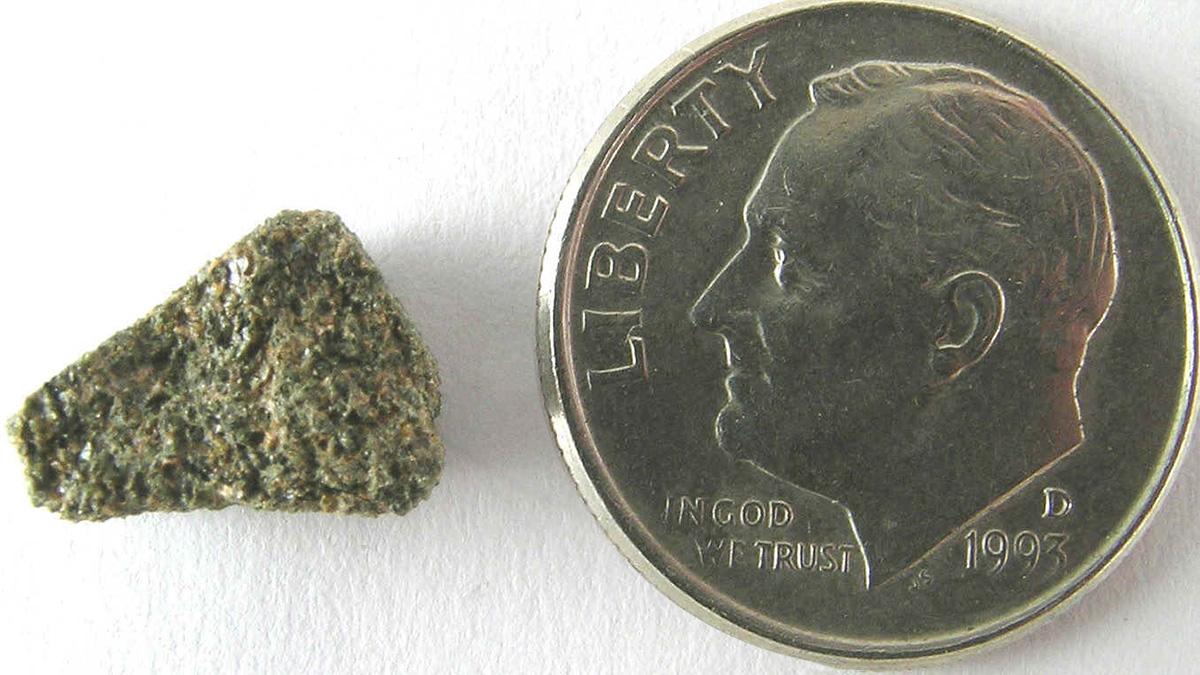“Would you like to hold a meteorite?” The question was unexpected, but not entirely out of the blue—I was, after all, at a meeting of The Meteoritical Society. As a hefty but unassuming-looking rock was placed into my cupped palms, scientists began to gather around. “I’ve been studying meteorites for years, and I’ve never seen something like that,” one told me in an excited whisper.
The rock I held that day in Glasgow, Scotland, was indeed special: It was literally a chunk of Mars. Martian meteorites, which were originally blasted off the surface of the Red Planet by a piece of an asteroid, are exceedingly rare: Only about 180 have been discovered on Earth. For comparison, more than 60,000 “regular” meteorites—that is, erstwhile members of the asteroid belt—have been found to date.
Mars in the Laboratory
“This is what we have from Mars for now until we bring samples back.”
Martian meteorites are currently the only pieces of Mars that scientists can analyze in the laboratory. That’s what makes them so special, said Chris Herd, a planetary geologist at the University of Alberta in Edmonton, Canada, who studies Martian meteorites. “This is what we have from Mars for now until we bring samples back.” The total mass of all known Martian meteorites is about 200 kilograms, significantly less than the mass of Moon rocks brought back to Earth by Apollo astronauts.
Differentiating a Martian meteorite from more run-of-the-mill meteorites takes a bit of sleuthing. One way to determine whether a meteorite came from the Red Planet is to chemically analyze tiny bubbles of gas within it—bits of air are often naturally incorporated into rocks as they form. If a rock is a Martian meteorite, the gas inside it will chemically resemble Mars’s atmosphere, which was sampled in the 1970s by NASA’s Viking landers. Finding gas that matches the composition of the Martian atmosphere is a giveaway you’ve got a Martian meteorite, said Herd. “The Martian atmosphere is unique in our solar system.”
The vast majority of Martian meteorites found to date have been igneous rocks (including ALH84001, perhaps the most famous Martian meteorite of all). That’s because igneous rocks are stronger than their sedimentary cousins and are therefore better at tolerating the stress of an impact, some researchers believe. Regardless of the explanation, it’s clear that we’re getting a biased sample, said Melinda Hutson, a meteoriticist at Portland State University in Oregon and curator of the Cascadia Meteorite Laboratory. “There’s a bias to what’s ejected.”
Magma, Magma, Everywhere
Igneous specimens are valuable, however—they shed light on Mars’s deep interior and the magma that’s present there. By analyzing the chemistry and mineralogy of these igneous rocks, researchers have found that most Martian meteorites tend to separate into three groups known as shergottites, nakhlites, and chassignites. The chemical and mineralogical diversity of Martian meteorites implies that the composition of Mars’s mantle isn’t uniform, said Arya Udry, a planetary scientist at the University of Nevada, Las Vegas who studies Martian meteorites. “The mantle of Mars is pretty heterogeneous.”
That heterogeneity likely arose from the planetwide ocean of magma that once covered Mars. The belief that Mars once hosted a magma ocean represents a relatively recent shift in scientists’ thinking, said Hutson. “We went from having the Moon being the only thing with a magma ocean early on to thinking that all of the terrestrial planets might have had one at some point.”
“It looks like you’ve got a minimum of four, maybe up to 11, impact events that have given us meteorites.”
Martian meteorites are also revealing new clues about Mars’s impact history. Any impact that’s capable of launching Martian rocks to escape velocity and on into interplanetary space is bound to excavate a crater at least a few kilometers in diameter, scientists have shown. By homing in on relatively large craters located at higher elevations—where Mars’s atmosphere is thinner and therefore it’s easier for ejected material to escape—researchers are attempting to link specific craters to known Martian meteorites. It’s challenging work, said Udry. “You have to match the age of formation of those rocks, the age of ejection of those rocks, and the mineralogy as well. That’s not easy.”
Researchers recently used machine learning to determine that Mars’s Tooting impact crater is the most likely source crater of an ensemble of Martian meteorites. Those meteorites, a subgroup of shergottites, are believed to have been ejected from the Red Planet roughly 1 million years ago. Work like this is cutting edge when it comes to Martian meteorites, said Herd. “Can we start to actually pinpoint where these things are coming from? There’s published literature now that says that yes, we can actually do that.”
Using the estimated ages of Martian meteorites, scientists also have deduced that just a handful of impacts on Mars were responsible for kick-starting these rocks’ journeys toward Earth. “It looks like you’ve got a minimum of four, maybe up to 11, impact events that have given us meteorites,” said Hutson.
Wanted: More Pieces of Mars
Martian meteorites are offering tantalizing glimpses of the Red Planet, said Udry, but the picture is far from complete. That’s not only because most of these rocks are igneous but also because they’re overwhelmingly young. “Most of them are younger than 2.4 billion years old,” said Udry. Mars, like the other planets in the solar system, is over 4 billion years old. We’re missing a lot of information, said Udry. “That’s really half of the Martian geological history that’s not represented by Martian meteorites.”
What scientists would really like to have are more Martian meteorites, preferably representing a range of rock types and ages. And although it’s impossible to conjure up these stones, of course, researchers have a trick up their sleeves: NASA’s Perseverance rover, part of the Mars 2020 mission, is caching rock and soil samples as it traverses Mars’s Jezero crater. The intent is that future missions to the Red Planet will retrieve and return these samples to Earth for analysis. With Perseverance, we’re now able to select the samples we want, rather than relying on what’s delivered to our planet by chance, said Herd. “Instead of nature choosing where the samples come from, we get to choose.”
Being listed as a coauthor on a scientific paper is “an honor that cannot be expressed in euros or dollars.”
Not surprisingly, meteorite collectors have also taken a fancy to Martian meteorites. For meteorite aficionados like Ben Hoefnagels, who handed me the rock I held in Glasgow, Martian meteorites are fascinating for many reasons. They’re valuable to science, and there’s also the thrill that comes with holding something from another world, he said. Hoefnagels has more than 15 Martian meteorites in his collection, and he regularly sells, lends, or even gives away pieces of his stones to scientists. Sometimes researchers return the favor by including Hoefnagels as a coauthor on a paper. “For me, not being a scientist at all, that’s just wonderful,” said Hoefnagels, a tax adviser turned entrepreneur in the Netherlands. “That’s an honor that cannot be expressed in euros or dollars.”
—Katherine Kornei (@KatherineKornei), Science Writer
This news article is included in our ENGAGE resource for educators seeking science news for their classroom lessons. Browse all ENGAGE articles, and share with your fellow educators how you integrated the article into an activity in the comments section below.


